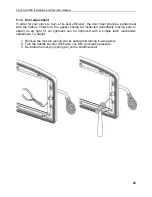
Century S245E Installation and Operation Manual
17
4.3
Maintaining Wood Fires
4.3.1 General
Advice
Wood heating with a space heater is very different than other forms of heating. There will
be variations in the temperature in different parts of the house and there will be variations
in temperature throughout the day and night. This is normal, and for experienced wood
burners these are advantages of zone heating with wood.
Do not expect steady heat output from your stove. It is normal for its surface temperature
to rise after a new load of wood is ignited and for its temperature to gradually decline as
the fire progresses. This rising and falling of temperature can be matched to your
household routines. For example, the area temperature can be cooler when you are active,
such as when doing housework or cooking, and it can be warmer when you are inactive,
such as when reading or watching television.
Wood burns best in cycles. A cycle starts when a new load of wood is ignited by hot coals
and ends when that load has been consumed down to a bed of charcoal about the same
size as it was when the wood was loaded. Do not attempt to produce a steady heat output
by placing a single log on the fire at regular intervals. Always place at least three, and
preferably more, pieces on the fire at a time so that the heat radiated from one piece helps
to ignite the pieces next to it. Each load of wood should provide several hours of heating.
The size of each load can be matched to the amount of heat needed.
When you burn in cycles, you rarely need to open the stove’s loading door while the wood
is flaming. This is an advantage because there is more chance that smoke will leak from
the stove when the door is opened as a full fire is burning. This is especially true if the
chimney connector has 90 degree elbows and if the chimney runs up the outside wall of
the house.
To avoid an excessive amount of embers and/or ashes from falling outside the unit, if the
ash level exceeds the lower door opening, it is recommended to open the ash drawer
approximately 4” (10 cm) before opening the loading door.
IF YOU MUST OPEN THE DOOR WHILE THE FUEL IS FLAMING, OPEN THE AIR
CONTROL FULLY FOR A FEW MINUTES, THEN UNLATCH AND OPEN THE DOOR
SLOWLY.
4.3.2 Ash
Removal
Ash should be removed from the firebox every two or three days of full time heating. Do
not let the ash build up in the firebox because it will interfere with proper fire management.
The best time to remove ash is after an overnight fire when the stove is relatively cool, but
there is still some chimney draft to draw the ash dust into the stove and prevent it from
coming into the room.
After ashes have been removed from the stove and placed in a tightly covered metal
container, they should be taken outside immediately. The closed container of ashes should
Содержание S245E
Страница 8: ...Century S245E Installation and Operation Manual 8 ...
Страница 31: ...Century S245E Installation and Operation Manual 31 Clearances to combustible materials and floor protection ...
Страница 45: ...Century S245E Installation and Operation Manual 45 Appendix 3 Exploded Diagram and Parts List ...
















































